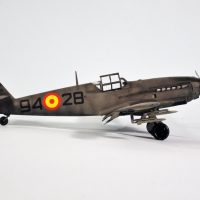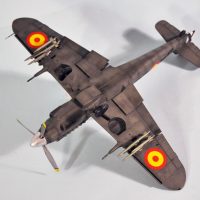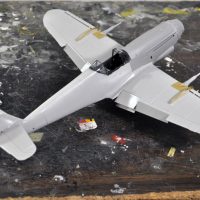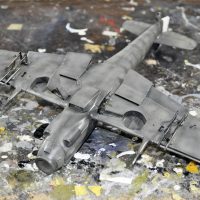Buchon Scale Models/Hasegawa 1/32 Hispano Aviation HA-1112-K1L “Tripala”
The Airplane:
Spain became one of the first foreign users of the Bf-109 when the Condor Legion departed Spain after the Civil War leaving behind their Bf 109s. During the Second World War, the Spanish received a number of Bf-109Fs and in 1942 Hispano of Spain negotiated an agreement with Messerschmitt to license manufacture 200 Bf-109G-2 fighters. The consequences of this would be lengthy, complicated, and confusing.
Hispano was supposed to receive 25 disassembled Bf-109G-2s to begin production, but deliveries faltered as things went from bad to worse for the Third Reich. By late 1944, Hispano had 25 Bf-109G-2 airframes and no DB 605s. Deciding they would never see the engines, Hispano engineers re engineered the airframe to use the Hispano Suiza 12Z 89 engine, providing 1,300 h.p. Performance was not appreciably better than the aging Bf-109Es. The first of these flew on March 2, 1945,
The Hispano Suiza engine was an upright V instead of an inverted V, which demanded airframe changes. It also rotated in the opposite direction which gave problems on takeoff since the airfoil of the vertical fin had been designed to counteract opposite torque; here engine and tail wanted to go the same direction. The first production airplane of the 25 modified Bf-109G-2s with the Hispano Suiza engine was flown July 10, 1947, designated HA-1109-J1L, with the remainder of the 25 completed to a similar standard. Performance was unsatisfactory and the Spanish Air Force (Ejercito del Aire) did not accept them.
Hispano tried again with the Hispano Suiza 12Z 17, which was no more powerful than the 12Z 89, but had many improvements, including fuel injection, and was generally regarded as more satisfactory, with a maximum top speed of 385 mph. Production of the HA-1109-K1L began in 1951 and it was accepted into service as the "C 4J". Four were taken off the production line and experimentally fitted with different armament. One was fitted with the originally-intended armament of a Breda SAFAT 13 millimeter machine gun in each wing, while another was fitted with twin Breda SAFAT guns in the cowling and underwing launchers for eight 80 millimeter Oerlikon rockets to test its usefulness in the close support role. A third was equipped with rocket rails but no guns. A fourth was fitted with one Hispano HS 404 20 millimeter cannon in each wing, plus rocket rails for eight rockets. This was found acceptable and most of the rest of the HA 1109 J1Ls, which were then redesignated HA-1112-K1L by Hispano, were modified with the 12Z 17 engine and the wing cannon armament, though they were still designated C-4J by the Air Force. Two prototypes of an unarmed two seat conversion trainer were also built, with the designation HA 1110, which were also designated C-4J. Even with the desired armament, the air force only used the HA 1112 K1L as an operational trainer. Hispano Suiza abandoned production of the 12Z engine in late 1952. In service, the airplane received the nickname “Tripala” for its three-bladed prop.
Two of the unarmed HA-1109-K1Ls were used in 1956 for the filming of the German motion picture “Der Stern von Afrika,” a “biopic” of Hans-Joachim Marseille and one of the first German films to deal with World War II. The film can be found nowadays with English subtitles YouTube and is not bad. The Hispano-powered K1L looks much more like a Daimler-Benz-powered Bf-109 than does the Merlin-powered M1L that has stood in for Bf-109s in every World War II movie involving Luftwaffe fighters made since.
The Kit:
Buchon Scale Models is owned by Espen Tjetland, who is involved in designing and producing resin conversion kits when he isn't doing his “day job” - flight demonstration pilot of the flying Norwegian Spitfire IX. The conversion parts have been produced by SBS Models in Hungary, one of the best resin kit parts manufacturers in the business, and is essentially a scale-up of their 1/48 kit of the same airplane. They were originally released via Facebook in 2019 by Attitude Aviation, which became Buchon Scale Models this year when the wing armament kits became available.
The kit is designed to be used with any Hasegawa 1/32 Bf-109G-2/4/6 kit. Decals are provided for an unarmed HA-1109-K1L, the HA-1109-K1L masquerading as Marseilles' “Yellow 14" for the movie Der Stern von Afrika, and a fully-armed HA-1112-K1L.
Construction:
When Espen contacted me last year and asked if I would like to review his two kits (also the Merlin M1L), I said yes, and found two ProModeler releases of the Bf-109G-2/4 at attractive (read: very cheap) prices on the used kit shelf at my LHS. The two kits arrived, but the separate wing armament sets had not yet been completed. After the wing kits arrived this past summer, I prepared to do both once I completed the manuscript for my next book and turned it in.
The engine conversion is quite simple, with clear instructions. The forward fuselage of the Hasegawa kit is cut off on panel lines, then the plastic kit is assembled and the cowling and lower radiator housing are then glued in position. Anyone who has built one of the Hasegawa kits and knows how to successfully wield a razor saw will have no problem with this conversion. Do take your time in sizing and cutting the lower center section of the fuselage, so that when you fit the radiator housing you will not adversely affect the fit of the wings.
The wing armament is a bit more time-consuming, but not really difficult. Again, the instructions on where to place the photoetch parts are clear; I also opened up the cannon shell ejection ports. The brass rocket rails have resin “feet” and are also easy to position properly following the instructions. The gun barrels would have been better had they too been made of metal; since they are resin and easily broken off if you install them at this stage, I advise not attaching them till all assembly, painting and decaling is completed.
The resin propeller spinner has to be cut off its molding block, which takes some skill with the razor saw to keep cutting where one is supposed to. The resin propeller blades are keyed so they will only fit at the proper angle.
Painting:
From a color photo supplied to me by Espen of an operational HA-1112-K1L and another color photo I found on the internet of the specific airplane covered in the decals, taken at the end of its service, I concluded that the color used by the Ejercito del Aire was closest to a mixture of Tamiya “XF-51" Khaki Drab, with about 20% Tamiya XF-22 “RLM Grau.” The airplane was painted this color overall, including the landing gear and gear wells.
Since a model this large in a monochromatic paint scheme will look quite boring, I decided to do a representation of the airplane after it had spent a few years fading under the hot Spanish sun. I painted the rudder XF-2 Flat White, then masked it off. I primered the model overall with X-18 “Semi-gloss Black.” The final paint was applied thinned 60 paint - 40 thinner, then some light grey was added for post shading overall, with some Flat White added for a third pass over the upper surfaces. The final result was an interesting multi-hue paint job.
The propeller blades and the rocket rails were painted with Vallejo “Duraluminum,” while the spinner was painted with Vallejo “White Aluminum”.
Decals:
The decals supplied with the kit are of excellent quality and completely opaque. They went on with an application of Solvaset and snuggled down without problem.
Final Finish and Assembly:
I gave the model an overall coat of Tamiya Clear Flat, then unmasked the canopy and posed it open. I assembled the prop and glued it in position, and finished off by attaching the exhausts. Per photos, I applied some light exhaust stains with Tamiya “Smoke.”
Overall:
The HA-1112-K1L is, to my mind, a better-looking airplane than the final Merlin-powered M1L, and is actually an aesthetic improvement on the DB-605 powered German airplanes. The kit is an easy conversion and would be a good first conversion kit project. For 109Nutz, this fills a position in the development history of the 109 and does so very nicely. Highly recommended.






























Very nice build
You must have money to burn as you use a Jackson Pollock as your work bench .
1 attached image. Click to enlarge.
That's a very cool looking 109, with those chin scoops and wing fences, among the other shape differences. It appears a more shark-like 109! Nicely finished as well (as usual!).
Great result, Tom.
And great historical background.
That is definitely an interesting paint job, Tom. I really like it.
Impressive build, Tom.
Really loved following your build progress.
Thanks for sharing the historical background.
Nice! Didn't these appear in the movie 'Battle of Britain' ?
Not the Tripalas. The Buchons did. Many of the same airframes, but different powerplants. The Buchons are Merlin-powered.
Great build and the paint is especially effective, Tom (@tcinla). The Spanish markings really stand out well against the paint.
Looks very interesting! Also history of the plane.